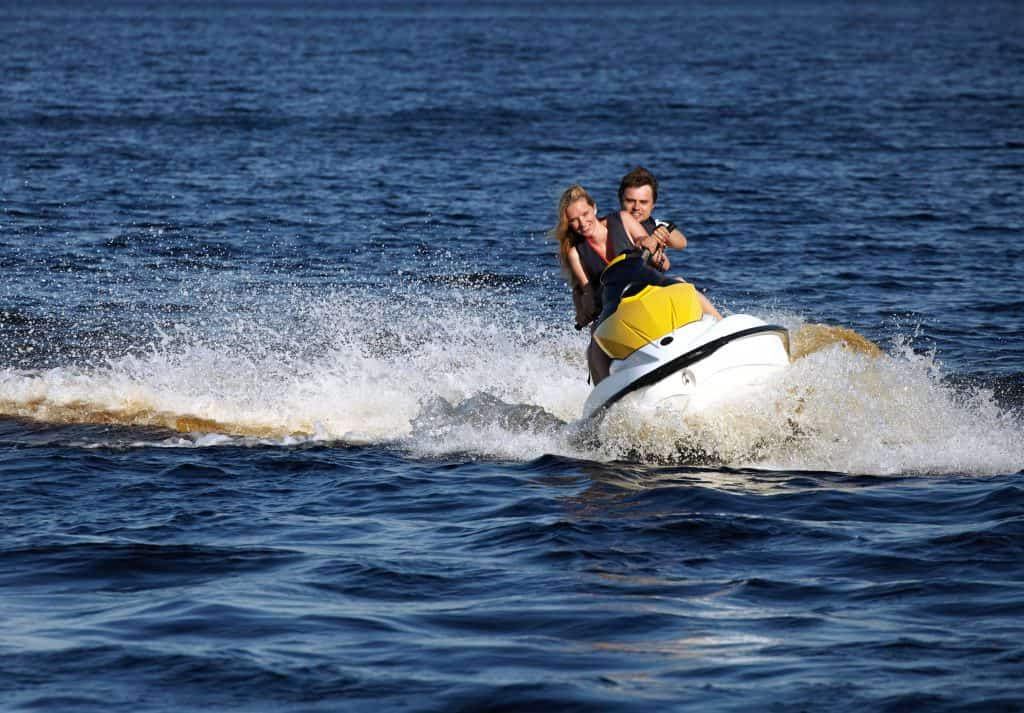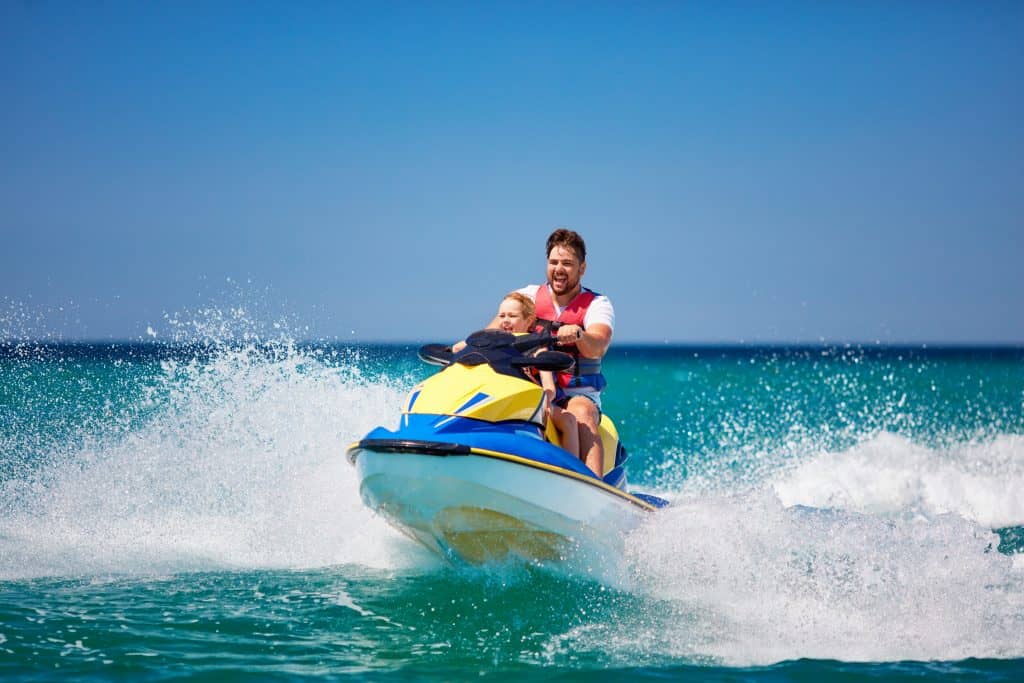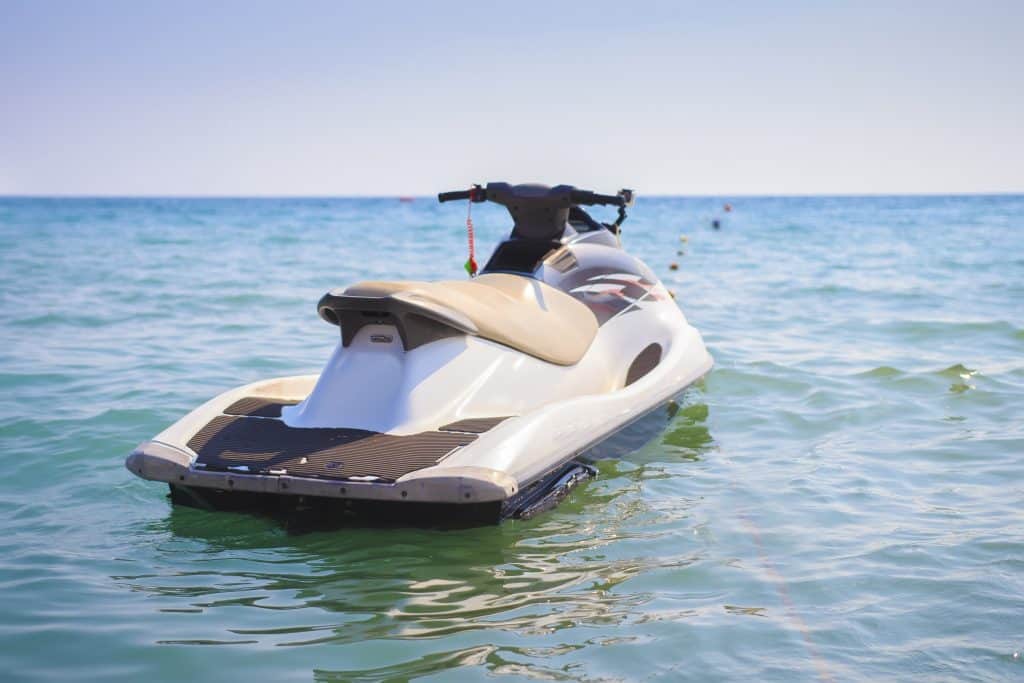Jet skis are a great way to spend time on the water in the summertime and create some memorable times with family and friends. In order to have a great time, you will need to know the laws for riding a jet ski according to the state you reside in. Rules and regulations can vary from state to state and it is a need-to-know in order to be able to enjoy your time on the water.
If you are at least 10 years old and if you are born on or after May 1, 1996, you can operate a Personal Watercraft Vehicle only if: you passed a boating safety course that is approved by the New York State Office of Parks and you must carry your Boating Safety Certificate on board with you as well. Or you can be accompanied by a person of 18 years of age or older who has a certificate as well.
It is important to be aware of the following regulations and laws for riding a jet ski on the water within the state of New York. By doing so you are responsibly following the law and that will guarantee you have an adventurous and stress-free time on your jet ski with family and friends.

The Basics
Before Heading Out Onto The Water
Who Can Operate a PWC
New York has placed the following restrictions on operating a PWC.As of January 1, 2009, the following requires you to:
- Be at least 14 years of age
- You must pass a boating safety course that has been approved by the New York State Office of Parks, Recreation and Historic Preservation
- It is also required of you to carry your Boating Safety Certificate on board your PWC
- You cannot rent a PWC if you are under the age of 16
While You’re On The Water
Reckless Operation of a Vessel
- Failure to Regulate Your Speed
This is operating your vessel at a faster rate than recommended, especially during vessel traffic, poor weather conditions, and closeness to shore. Some examples of this are:
- Operating your vessel at extreme speed in the close vicinity of another vessel, PWCs, or dangerous waters
- Operating at a greater speed than “slow, no wake speed” that is posted in a “no wake” zone
- Going faster than the speed limit posted near the body of water you are operating on
- Going at a speed that can be harmful to your vessel
- Improper Distance Between Others
If you are operating your vessel faster than 5 mph while operating within 100 feet of the shore, dock, pier, raft, float, or an anchored or moored vessel you are operating your vessel improperly and putting others around you at risk.
- Riding on the Bow, Deck or Gunwale of a Vessel
Riding on anything that is not equipped with fixed seating can lead to the potential of falling overboard. Do not allow your passengers or yourself to sit on seat backs, transom, gunwale, seats on raised decks or a bow.
- Reckless Operation Specifics
This is when you weave through traffic, swerve last minute to avoid a head-on collision with another vessel, or overload your vessel beyond the capacity it states on the plate.
- Unsafe Conditions
Not having enough personal flotation devices, fire extinguishers, backfire flame arrestors, ventilation systems, or navigational lights are putting yourself and others aboard your vessel at risk.
You also put yourself and others in danger when you overload or overpower your boat, or when if you are operating the vehicle while intoxicated
Boating or PWC Accidents…What You Should Do
In the event of a PWC or boating accident you must do the following:
- Stop the vessel at that very moment
- Assist the person who was injured
- Give, in writing, the name of the person, their address, and the vessel identification number to the owner of the property that was damaged
- To report an accident you can contact the Office of Parks, Recreation and Historic Preservation Agency Blvd. #1, Empire State Plaza in Albany, NY 12238
Laws and Regulations
Before You Go Out Onto the Water
Register Your Vessel
Registering your vessel is a step towards being able to lawfully riding it on the water. There are requirements for registering your vessel that you will need to consistent on taking care of first.
To begin registering your vessel you will need to complete the Boat Registration/Title Application, registration fee, proof of ownership, proof of paying sales tax, and a bill of sale. you must complete and bring all of these documents to the DMV District Office.
Once you receive your registration number and the validation stickers you must display these items in the following ways:
- Each number has to be painted, applied onto your vessel as a decal, or place to be shown on both sides of the bow
- The numbers must read from left to right on both sides
- Each number must be in block letters and three-inches high
- The color of your numbers must also be in contrast with the background of your vessel
- The letters have to be separated from the numbers with space or a hyphen
- There cannot be any other numbers shown on the bow
Hull Identification Number
A Hull Identification Number (HIN) is a 12-digit number that is assigned by the manufacturer to vessels built after 1972. They help be able to determine the difference between multiple vessels.
In case your vessel is stolen you should write down your HIN number and put it somewhere safe.
Registering Boat or PWC Fees
| LENGTH | REGISTRATION FEE | SURCHARGE | TOTAL |
| Less than 16 feet | $22.50 | $3.75 | $26.25 |
| 16 feet to less than 26 feet | $45.00 | $12.50 | $57.50 |
| 26 feet or longer | $75.00 | $18.75 | $93.75 |
You may also need to pay a $50 titling fee depending on the size, and age of your boat. Your boat registrations are issued for about 3 years.

Required Equipment
Personal Flotation Devices
| Type 1 | Offshore Life Jackets | This vest can turn an unconscious person in the water to face up in the water. It was made for rough waters and for situations where rescue might take a long time. |
| Type 2 | Near-Shore Vests | This vest is fit for calmer waters and faster rescues. If you were to wear this while unconscious it may not be able to turn your face up in the water. |
| Type 3 | Flotation Aids | This vest can also be a full-sleeved jacket and it is great for calm waters and fast rescues. This will definitely not turn your face up in rough waters. This is generally worn for water sports. |
| Type 4 | Throw able Devices | This type of flotation device is a cushion or ring buoys and are typically used to throw at someone in trouble. They are not made to last for long hours in the waters, or non-swimmers, or the unconscious. |
| Type 5 | Special-Use Devices | This type of flotation device was made for activities like kayaking, water-skiing These typically look like white water vests, deck suits, and personal flotation device hybrids. |
Navigation Lights
Power-Driven Vessels When Underway
The lights required on a vessel like this one is:
- Red and green sidelights that can be visible from at least 2-miles away, and at least a mile away on a clear, dark night.
OR
- An all-round white light that can be seen from at least two miles away on a dark, clear night. The lights must be 3.3 higher than your sidelights.
Unpowered Vessels When Underway
Lights required for this vessel are:
- Red and green sidelights that can be seen from two miles away. The sunlight must also be visible from 2 miles away.
OR
- You can bring on board a lantern or flashlight that shines white light.
All Vessels When Not Underway
ALL vessels must show a white light in all directions if they are anchored outside a mooring area between the hours of sunset and sunrise.
Fire Extinguishers
You can classify your fire extinguisher by letter and number symbol. The number helps you decipher the size of the extinguisher, and the letter indicates the type of fire that is extinguished as well.
Type A fires – are of combustible solids such as wood
Type B fires – these are flammable liquids like gasoline or oil
Type C fires – this is mainly electrical fires
All vessels are required to have a Type B fire extinguishers on board in the case of any extreme or dangerous situations occurring.
Your fire extinguisher should be placed somewhere easily accessible in the case of a situation where it needs to be used immediately.
Ventilators
The ventilation system is extremely important to have installed in your vessel. Their main purpose is to reduce the chances of an explosion from happening.
- All vessels powered by gasoline are created in a way that it would be able to entrap fumes, have two ventilation ducts with cowls that help remove those fumes
- If you happen to have a vessel without a powered ventilation system you can open the engine compartment and smell for any gasoline fumes before you start up your engine
- Before you start the engine or your vessel and after fueling it you should turn it on for at least 4 or 5 minutes if it is equipped with a power ventilation system
Mufflers
- In New York, it is against the law to install muffler “cut-outs”
- It is also against the law to alter, modify or even remove your muffler system in a way that will prevent your PWC or vessel from meeting these standards

Rules and Regulations Specific to PWC
Alcohol and Drugs
To be under the influence and operate a vessel is irresponsible. You need to be considerate of the fact BUI can put yourself and others in harm’s way.
To the state of New York, you are considered to be Boating Under the Influence when your blood alcohol concentration is 0.08% or greater.
There is a “zero tolerance” policy for those under the age of 21. This is enforced for minors whose blood alcohol concentration is between 0.02% and 0.07%.
Those individuals that are under 21 and are caught for boating under the influence can have their privileges suspended or revoked. You can also be subjected to heavy fines, imprisonment, or suspension of operator privileges.
Discharge of Trash, Waste and Hazardous Substances
Trash
- When it comes to charging trash, it is illegal to dump plastics or garbage into any federally controlled or even state waters. You have to keep your trash on board, sealed and contained to where it will not fall out.
Waste
- When it comes to the disposal of the waste you will need to have a marine sanitation device (MSD) while traveling on New York state waters.
Hazardous Substances
- It is illegal to dump hazardous substances into the waters. A fine that can be imposed on you for failing to follow this regulation can be up to $10,000
- If your vessel happens to discharge oil or any other hazardous substance you must contact the U.S. Coast Guard immediately and call 1-800-424-8802
Other Requirements for PWC
- You cannot operate a personal watercraft vehicle within 500 feet of a designated swim area.
- Reckless operation of a PWC is not allowed. Examples of this:
- Jumping a wake too close to other vessels
- Last minute avoidance of collision
- Weaving carelessly through vessel traffic
- Carrying more passengers on your PWC than is recommended
- If you maneuver your PWC in such a way that it can cause unreasonable harm to you or your passengers
- It is illegal to operate a personal watercraft vehicle between the hours of sunset and sunrise especially when your vision is a bit restricted.
- You cannot remove any backfire flame arrestor or ventilator if it is installed by your manufacturer
- You must have a whistle or horn on board your PWC that is U.S. Coast Guard approved
- The safety ignition switch must be fully functional and have a lanyard attached to it to ensure it does not get lost or misplaced
- Each person on the PWC must wear a U.S. Coast Guard approved type 1,2 or 3 personal flotation device
Enforcement
The boating laws and regulations are enforced by the following State Park police, sheriff departments, local, county, and State police, the Department of Environmental Conservation, and Harbormasters and Bay Constables.
Those following individuals have the authority and power to stop and test a vessel operator if they feel they have enough reason to do so.
It is also illegal to refuse to follow the directive of someone with law enforcement authority.
